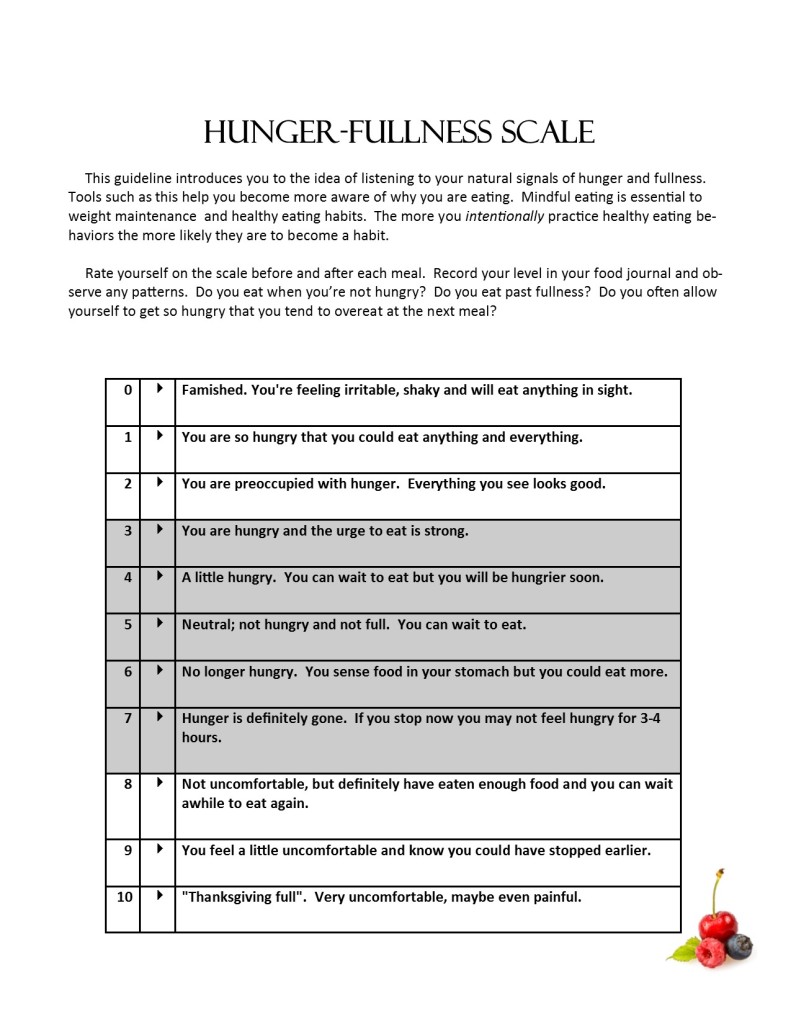Mindful Eating-The When?

The Mindful Eating Cycle (image here)
Last week I introduced the Mindful Eating Cycle, a simple model developed by Dr. Michelle May, an expert in mindfulness and specifically mindful eating. Her website can be found here. In helping us get a better handle on our eating patterns which ultimately impact our health it is important to know WHY? we eat. Go to my previous post here. Once we start asking the WHY? and have figured out the reasons for eating, it’s time to start asking, the WHEN? When do I eat? When do I feel like eating? AM I HUNGRY? How can I tell if I’m hungry? Most adults need to eat every 3-4 hours to satisfy our physiological hunger, that gnawing feeling of emptiness in our gut which sends chemical signals to our brain that says, feed me! Maybe you get a headache or feel light headed when blood sugar gets too low. When we were young, we identified our hunger pretty intuitively, but when culture “hit the spoon” and we started using food for reasons that had nothing to do with hunger, we began to lose track of what it means to be hungry. Additionally, the heavier we get, the less sensitive our cells are to the chemical signals of hunger AND fullness for that matter, thus upsetting the natural cycle of hunger and fullness that is so important to our food regulation and appetite control.
You’ve set a goal to avoid using food as your primary coping mechanism and instead want to use food to feed your physiological hunger. With every eating experience or urge to eat, you’re asking yourself Am I Hungry? Let’s talk about your hunger. On a scale of 0-10 with 0 being famished and 10 being Thanksgiving stuffed, how hungry are you? Take a look at the Hunger Fullness scale below.
 Ideally you should be eating when your hunger is around a 3, not letting yourself get too hungry where you tend to then overeat. Conversely, you want to eat to about a 7, where you’re not uncomfortable, but rather feel satisfied knowing you can eat again in another 3-4 hours. Eating to overstuffed is uncomfortable, it adds extra calories, sends your insulin response into overdrive triggering fat production and storage. not to mention the added guilt from feeling out of control. I’ll write more about the HOW? but simply put, if you eat slowly you’ll improve your chances of not overeating since it takes about 20 minutes for your body to sense fullness (a very interesting chemical-triggered pathway that we often completely ignore).
Ideally you should be eating when your hunger is around a 3, not letting yourself get too hungry where you tend to then overeat. Conversely, you want to eat to about a 7, where you’re not uncomfortable, but rather feel satisfied knowing you can eat again in another 3-4 hours. Eating to overstuffed is uncomfortable, it adds extra calories, sends your insulin response into overdrive triggering fat production and storage. not to mention the added guilt from feeling out of control. I’ll write more about the HOW? but simply put, if you eat slowly you’ll improve your chances of not overeating since it takes about 20 minutes for your body to sense fullness (a very interesting chemical-triggered pathway that we often completely ignore).
How do I get back in control of this natural cycle? Start by asking yourself before every eating experience: AM I HUNGRY? If the answer is yes, then you decide the WHAT? What does my body need for nourishment? I’ll discuss the WHAT next week. If the answer is no, then you must ask yourself: What do I want this food to do for me? What are the triggers to my eating? How can I better cope with my triggers? For example, you might find yourself eating as a result of stress in your life. Instead of eating, better coping mechanisms might include relaxation techniques, a good walk outside, massage, a new hobby. As we recognize our triggers to eating and deal more appropriately with those triggers we will develop a healthier relationship with food, be more in control of our eating and finally overcome habits that have been holding us hostage . Remember Dr. May’s definition of normal eating: “a natural, healthy and pleasurable activity for satisfying hunger.” So simple.
Next time you’re tempted to eat and recognize that you’re not really hungry but are attempting to use food as your coping mechanism, STOP and evaluate. Accept that food is not the answer to dealing with the eating trigger, that it never is the answer and in fact, will more likely lead to more stress and anxiety from the ensuing guilt associated with overeating or eating foods that are not nourishing or do not bring enjoyment.
To help you understand more about your eating patterns, take Dr. May’s Eating Cycle Assessment, found here.
Next week I’ll cover the WHAT? to eat once we’ve decided that we truly are hungry. WHAT do I need to provide nourishment, enjoyment and satisfaction?

